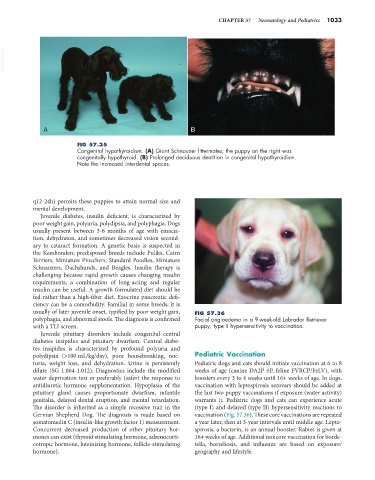Page 1061 - Small Animal Internal Medicine, 6th Edition
P. 1061
CHAPTER 57 Neonatology and Pediatrics 1033
VetBooks.ir
A B
FIG 57.35
Congenital hypothyroidism. (A) Giant Schnauzer littermates; the puppy on the right was
congenitally hypothyroid. (B) Prolonged deciduous dentition in congenital hypothyroidism.
Note the increased interdental spaces.
q12-24h) permits these puppies to attain normal size and
mental development.
Juvenile diabetes, insulin deficient, is characterized by
poor weight gain, polyuria, polydipsia, and polyphagia. Dogs
usually present between 3-6 months of age with emacia-
tion, dehydraton, and sometimes decreased vision second-
ary to cataract formation. A genetic basis is suspected in
the Keeshonden; predisposed breeds include Puliks, Cairn
Terriers, Miniature Pinschers, Standard Poodles, Miniature
Schnauzers, Dachshunds, and Beagles. Insulin therapy is
challenging because rapid growth causes changing insulin
requirements; a combination of long-acting and regular
insulin can be useful. A growth formulated diet should be
fed rather than a high-fiber diet. Exocrine pancreatic defi-
ciency can be a comorbidity. Familial in some breeds, it is
usually of later juvenile onset, typified by poor weight gain, FIG 57.36
polyphagia, and abnormal stools. The diagnosis is confirmed Facial angioedema in a 9-week-old Labrador Retriever
with a TLI screen. puppy; type II hypersensitivity to vaccination.
Juvenile pituitary disorders include congenital central
diabetes insipidus and pituitary dwarfism. Central diabe-
tes insipidus is characterized by profound polyuria and
polydipsia (>100 mL/kg/day), poor housebreaking, noc- Pediatric Vaccination
turia, weight loss, and dehydration. Urine is persistently Pediatric dogs and cats should initiate vaccination at 6 to 8
dilute (SG 1.004-1.012). Diagnostics include the modified weeks of age (canine DA2P ±P, feline FVRCP/FeLV), with
water deprivation test or preferably (safer) the response to boosters every 3 to 4 weeks until 16+ weeks of age. In dogs,
antidiuretic hormone supplementation. Hypoplasia of the vaccination with leptospirosis serovars should be added at
pituitary gland causes proportionate dwarfism, infantile the last two puppy vaccinations if exposure (water activity)
genitalia, delayed dental eruption, and mental retardation. warrants it. Pediatric dogs and cats can experience acute
The disorder is inherited as a simple recessive trait in the (type I) and delayed (type II) hypersensitivity reactions to
German Shepherd Dog. The diagnosis is made based on vaccination (Fig. 57.36). These core vaccinations are repeated
somatomedin C (insulin-like growth factor 1) measurement. a year later, then at 3-year intervals until middle age. Lepto-
Concurrent decreased production of other pituitary hor- spirosis, a bacterin, is an annual booster. Rabies is given at
mones can exist (thyroid stimulating hormone, adrenocorti- 16+ weeks of age. Additional noncore vaccination for borde-
cotropic hormone, luteinizing hormone, follicle-stimulating tella, borreliosis, and influenza are based on exposure/
hormone). geography and lifestyle.

